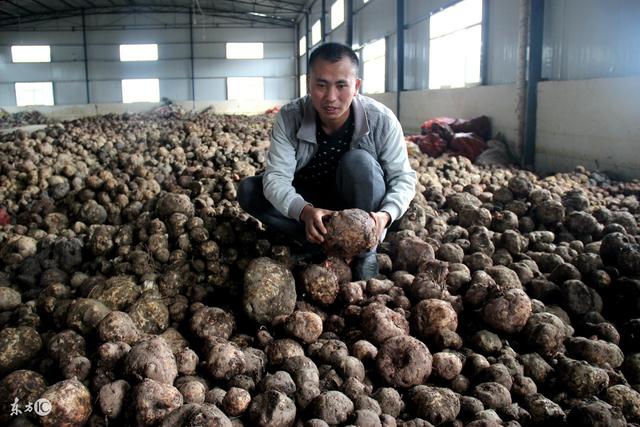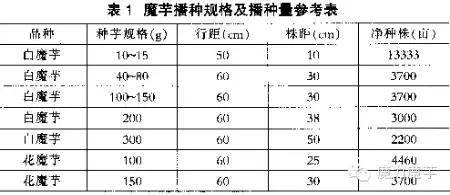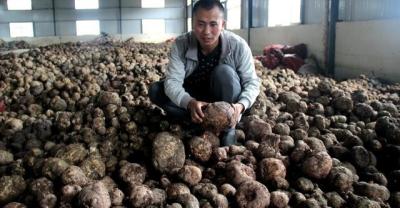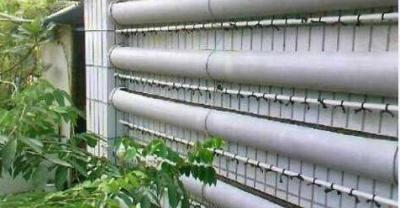Exploration on Biodiversity cultivation of Amorphophallus
Konjac is a perennial herb of Araceae, and underground tubers are rich in glucomannan, which is rare in other plants. The vast mountainous areas of Zhaotong, Yunnan Province are suitable for planting konjac. Yongshan County, Suijiang County, Zhaoyang District and Ludian County are the origin of Jinjiang White Konjac, and the content of glucomannan in White Konjac is up to 70%. Ranking first in China, these counties are also the most suitable areas for planting Amorphophallus. However, Zhenxiong, Yiliang, Daguan and other counties are more suitable for the cultivation of Amorphophallus due to climate (weak sunshine, high humidity, etc.). The planting area of konjac in Zhaotong reached 184700 mu in 2014. at the same time, the konjac industry has been designated as one of the eight dominant agricultural industries in Zhaotong.

Big konjac
Zhaotong City is located in the northeast of Yunnan Province, the transition zone from Yunling Plateau to Sichuan Basin. Konjac cultivation has a long history, unique climate resources, topography and rich soil resources, which provide good environmental conditions for the growth and development of Amorphophallus. At present, the promotion of the intercropping technology between Jinsha white konjac production base and konjac established in Zhaotong has made a great contribution to the production of konjac in the whole province and the whole country. at the same time, there are still some problems in the industry of Zhaotong konjac, such as variety degradation, serious diseases and insect pests, high production cost and so on.
1 growth habits of konjac
The soil planted with konjac should be rich, loose, thick sand and sandy loam containing humus, like cool climate, more resistant to shade and humidity, avoid continuous cropping, and the interval should be 2-3 years. The suitable temperature for the growth of konjac is 25 ℃, and the growth is stopped below 15 ℃: konjac avoids strong light and likes a shade of 30-90%; the requirement for air humidity of konjac is 80%, and the soil moisture is about 70%.
2 cultivation techniques of konjac
2.1 choose a suitable planting environment
Konjac is not suitable to grow in a dry environment, like fine moisture, so the choice of konjac soil is loose, high fertility, good drainage, thick soil layer and good ventilation environment. The farming operation of Amorphophallus konjac is not suitable after leaf exhibition, so it is necessary to apply sufficient base fertilizer before planting, which requires farm fertilizer 2000kg and compound fertilizer 100kg.
2.2 intercropping
The utilization rate of konjac for light is relatively low, and konjac does not like strong light, so intercropping can obtain the necessary shade and maintain an appropriate temperature. The general shade degree is 40% Mel 60%, and the summer temperature is 35 ℃, which is suitable for 50% Mel 80% shade. The key to intercropping lies in reasonable density and moderate shade, which can produce the standard of double benefit of intercropping and konjac. Konjac plant height is generally about 1m, intercropping crops generally choose corn, sunflower or deciduous fruit trees, deciduous economic trees, such as apple trees, silkworm trees and so on. Intercropping with corn generally adopts three rows of konjac intercropping and one row of corn; intercropping with sunflowers can be intercropped or intercropped with sunflowers. Today, when vigorously promoting Zhaotong sightseeing agriculture and channel agriculture, intercropping sunflowers among konjac is a planting model worth studying and popularizing, which is both beautiful and affordable: for orchards, there are more plants in places where seedlings are sparse, and less in close planting. Generally speaking, in the area of Zhaotong City, Yunnan Province, the net seed model of konjac should be adopted in the area above 1900m above sea level and in the mountainous area of shady slope, and it is suitable for interplanting at the altitude of 1900m.
The cultivation of diversity can make long-stalk crops and trees get more sunshine in the upper layer, while konjac gets proper shade in the lower layer. If intercropping with autumn sowing crops such as rape and wheat, it is necessary to select varieties that are precocious and not easy to lodge, and reserve the planting rows of konjac and corn to ensure that konjac sprouts can get enough light after they are unearthed, and corn can be sown or transplanted in time. Because the shallow root absorption of konjac is weak, the root system of intercropping crops can not affect the root development and nutrient absorption of konjac, so intercropping crops must cover special ridges and ensure their needs in the application of base fertilizer and topdressing. After September, the temperature and light gradually decreased.
Health, sunflower, corn and other late growth can remove the upper leaves, appropriately reduce its shade, in order to increase the light of konjac.
Moderate shading can prevent the disease of konjac and ensure high yield, so shading degree should be selected according to local conditions. Areas with long sunshine time and high temperature are suitable to choose 50%, 80% shade; if the temperature is not high, and the sunshine time is about 9 hours, it is suitable to choose 40%, 60% shading; in high altitude areas, the summer temperature is low or the north slope of the mountain area does not need shading.
2.3 sowing time
For Zhaotong area, according to the perennial planting experience, the sowing time should be at the end of March and the first and middle of April, and the sowing operation should be carried out when the temperature is stable above 14 ℃, and the sowing depth is about 5cm.
2.4 reasonable close planting
The seeds of konjac are divided into different varieties. According to the results of long-term practice, the seeds of white konjac are 100-150g in weight, while the seeds of flower color are 200-250g in weight. The planting of ① konjac needs to pay attention to these points: the space occupied by the aboveground stem and leaf part of Amorphophallus konjac is much larger than that of the underground part, which can reach about 10 times, so we should pay attention to the close planting specification when sowing, and the lower seed density should fully consider the relationship between the upper stem and leaf and the lower tuber root. Areas with soft and fertile soil should be sparse when planting, while the corresponding areas are denser. ② when planting konjac, we can properly consider interspersing the next species, that is, planting seeds of different sizes together, so that the upper structure of the land becomes layered, and the land use and light can be used reasonably. The sowing specifications and sowing rates of konjac are shown in Table 1.

(3) Prevention and treatment of diseases
3.1 soft rot
Symptoms of ① soft rot: Amorphophallus konjac is susceptible to soft rot throughout its life cycle, which mainly affects the corm, petiole and leaves of konjac. After infection, the tissue of konjac blackens and softens, and gives off a bad smell at the same time, and finally all the leaves turn yellow and lodging finally. At present, soft rot can be treated in the laboratory, but it has little effect in the field. ② control measures: on the one hand, implement konjac planting rotation planting, the longer the interval, the better, while taking interplanting measures, not only solve the problem of shading, but also control the disease; on the other hand, soak seeds with 10 million units of agricultural streptomycin for 1 hour before sowing, and spray leaves and petioles with 400 million units of agricultural streptomycin per mu during the growth period, 2-3 times a year. In short, for konjac, adopt the principle of "prevention first, comprehensive prevention and control".
3.2 White silk disease
① symptom: this disease affects the main part of konjac is the base of petiole, which gradually leads to the damage of corm. After the konjac was infected with white silk disease, some brown spots began to appear at the base of the petiole, which expanded over time, and finally the petiole grew into a white silk-like hyphae, showing a reddish color. Note that this mycelium grows faster in humid, hot, and long sunshine. ② prevention and control measures: remove 100kg quicklime per mu when sowing, carry out soil disinfection, make the soil weakly alkaline or neutral, and apply more organic farm manure can also reduce the probability of the disease; thoroughly remove disease residues, weeds, rural cleaning; check the disease at any time after July, find the central diseased plant, immediately dig away the deep burial or burn, remove lime in and around the nest, step on the soil: strictly prevent plant injury or insect bite. These methods are also effective in preventing soft rot.
3.3 Leaf blight
① symptoms: leaf blight often occurs from July to October. High temperature and humidity in summer and cool and humid in early autumn will make the disease spread rapidly and greatly reduce the production of konjac. As the name implies, leaf blight mainly harms the leaves of Amorphophallus. It is noted that the pathogen can survive the winter in the soil, and it may splash down on the leaves when it rains, and it may also invade from plant wounds and vents, and wind and rain can also spread the pathogen. Once the disease occurs, it will cause a massive reduction in production. ② prevention and control measures: select reasonable planting areas according to local conditions; select konjac with strong growth, show clear leaves or leave seeds in plots with slight disease by strict seed selection and chemical soaking; topdressing is also dominated by high-quality farm manure and potash fertilizer to make konjac grow steadily, and attention should be paid to farm manure when fertilizing.
3.4 other diseases
Mainly physiological diseases, including konjac sunburn, element deficiency and frost rot and so on. The harm of these diseases can be prevented in time, and the main measures are interplanting with high-stem crops, spraying foliar fertilizer and so on.
4 insect pests
Generally speaking, the loss of insect pests is not as large as that of diseases, and konjac only grows one compound leaf a year, which cannot be made up for after loss, and some diseases invade from the mouth, which will cause double losses. The common pests in konjac planting land are sweet potato armyworm, bean moth larva, beetle and some other aphids, mites and so on.
A small number of pests can be caught manually, and in serious cases, they should be eliminated by pesticide spraying; for some larvae, aphids and other pests, they need to be killed by spraying (they can be sprayed with 80-1000 times of trichlorfon or 1000-1500 times of dimethoate).
Storage of five kinds of taro
The best storage temperature of seed taro is 8-12 ℃, the highest cannot exceed 20 ℃, and the lowest cannot be less than 5 ℃; the storage humidity should be kept at 80%; and the storage methods include indoor storage, cellar storage and soil storage. During storage, attention should be paid to the disinfection of the storage environment and good ventilation should be maintained. For breeding fields, konjac can be harvested in March of the following year to reduce the susceptibility of seed taro.
6 the prospect of planting konjac
With the large-scale planting and promotion of konjac, konjac planting bases have been established in some places, we need to strengthen the variety of konjac, secondly, we should put in more labor production, and take some measures to improve the output and quality.
Konjac industry is a processing industry of agricultural products, we need to process end products to enhance industrial value and promote local economic development. Konjac initial processing needs to pay attention to these two points: ① color protection. This is a treatment measure to prevent browning of konjac after slicing and then affect the value of the product. Sulfite gas (sulfur dioxide) is generally used for color protection bleaching, but the dosage should be controlled below 300mg/kg, and 70-90 ℃ heat treatment can also effectively prevent browning. ② is dried. Artificial drying and natural drying, although the natural drying method is cheap, but the climate has a great impact on it, and the quality should not be guaranteed; the artificial drying temperature is easy to control, and the quality is very stable. Kang room or flue-cured tobacco room is generally used, and mechanical processing can be used if the conditions permit.
7 conclusion
Although konjac cultivation has a history of thousands of years, the real formation of the industry is also something in recent years. The cultivation of konjac biodiversity can bring win-win results, and the output value is far greater than the benefit of monoculture. At the same time, we also need to combine long-term planting experience to optimize planting and promote the development of konjac industry.
- Prev

What is hair loss and how to plant hair follicles?
Hair consists of hair root and hair rod. Hair root consists of hair follicles, hair papillae, hair mother cells, sebaceous glands, sweat glands, peripheral nerves, standing hair muscles and microvessels.
- Next

How to plant and transplant trees
With proper preparation and planning, you can increase the value and beauty of your compounds with trees. There are various types of trees that you can choose according to your taste and...
Related
- Fuxing push coffee new agricultural production and marketing class: lack of small-scale processing plants
- Jujube rice field leisure farm deep ploughing Yilan for five years to create a space for organic food and play
- Nongyu Farm-A trial of organic papaya for brave women with advanced technology
- Four points for attention in the prevention and control of diseases and insect pests of edible fungi
- How to add nutrient solution to Edible Fungi
- Is there any good way to control edible fungus mites?
- Open Inoculation Technology of Edible Fungi
- Is there any clever way to use fertilizer for edible fungus in winter?
- What agents are used to kill the pathogens of edible fungi in the mushroom shed?
- Rapid drying of Edible Fungi

